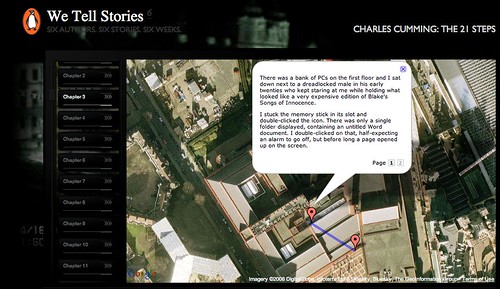“Je n’ai fait celle-ci plus longue que parceque je n’ai pas eu le loisir de la faire plus courte.” Pascal, Lettres provinciales, 16, Dec.14,1656.

I used to co-edit Pick Me Up, a cult London digital newsletter. After some years perfecting the flamboyant and self-congratulatory prose style that wins points as an Oxford undergrad, it was a whole new aesthetic. Minimal design, lots of white space. Keep the language plain, tell the story in simple words. We’d pass articles back and forth, ruthlessly prune one anothers’ words for anything too flash. I quickly stopped being precious about ‘my’ words: the aim was to make the language invisible.
Here’s my favorite ever Pick Me Up story.
Back then (we went our separate ways around 2 years ago), we were just-underground: our stories regularly hijacked by broadsheets and advertising campaigns. But since then the writing register I learned there has proliferated. It’s become the hip corporate copywriting style: Howies, Innocent Smoothies, any Web2.0 startup’s ‘About Us’ page.
Looking back, my involvement with Pick Me Up was the point where I started to think hard about the unique qualities of writing for the Web. But while plain language has become the bedrock of corporate communications, especially online, the ‘literary’ register resists its incursions. Wordsworth’s efforts notwithstanding, short sentences, plain language, and simple structure signify simple-mindedness. Discussing Japanese mobile phone fiction, Jane Sullivan writes in The Age
What’s the downside? Quality control, apparently. So far the mobile phone format has meant that the style of writing is generally unadventurous -? short, simple sentences, lots of dialogue, pauses to indicate thought -? and the stories themselves are hackneyed tales of romance.
I think it was Nietzsche who said that difficulty is often mistaken for greatness in a writer, because readers mistake their own pride at deciphering a text for an inherent profundity within it. Never mind that Pascal’s bon mot has been attributed to writers as long-gone and canonical as Cicero; forget brevity being the soul of wit; simplicity indicates poor quality.
Similarly. It’s become an article of faith in web design that any content below the fold (ie requiring a visitor to scroll down) will attract dramatically fewer viewings; this reflects a well-founded pragmatism oriented toward the need to hook a reader straight away. But few of the ‘literary’ webspaces I’ve come across in my research over the last few months pay much attention to this principle. I’ve lost count of the number of blog ‘novels’ I’ve come across, glanced through, bookmarked with every intention of returning for a closer read, and then forgotten. Part of the problem, again and again, is that I’m confronted with thousands of words of Arial ten-point and a scroll bar – along with the long sentences, elaborate structures and rich vocabulary that for many are the marker of literary quality. The net result is that these literary webspaces field a prose style and layout that – while it might make perfectly decent print reading – provides a sucky user experience.
My literacy credentials are more than respectable. I’m happy plowing my way through thorny texts – in the right form. But with billions of pages on the Web clamoring for attention, I get irritated with those that insist, however noble and literary their intentions, on making that most basic online error of loading too much text into one place. While the idea of savoring a sprawling, muscular Jamesian sentence in the wifi-free zone of the subway delights me, the idea of being asked to do so online fills me with horror.
Whatever you may think of the actual story, the first episode in Pengin’s WeTellStories experiment, The 21 Steps, suggests a growing recognition of the need to adapt storytelling modes online. It’s a decent balance of Web-native visualization and textual storytelling. The reader doesn’t have to deal with more than 20 or so words per click, 40-50 per ‘chapter’. The whole thing takes 5-10 minutes to read. This, in my view, is about where Web storytelling needs to be pitched.
Penguin’s production is an all-singing, all-dancing multimedia experince produced by an ARG studio. But simpler, text-based offerings are if anything more subject to the brutal need to edit for the Web reader’s attention span. Dickens’ chapter length was constrained in many cases by magazine serialization; now that DailyLit.com delivers daily bite-sized email or RSS doses of books to subscribers, will this affect the way future storytellers shape their work?
There is no disputing the fact that the Web is not the most comfortable medium for long-form reading (see Ian Bogost’s cracking article, and the ensuing discussion, for more on this). And the social media boom is spearheading a change in written language toward a simpler, plainer, more demotic register. So does this mean we are – over two centuries after Wordsworth’s Lyrical Ballads proposed a new literature embracing ‘the language of ordinary men’ – finally abandoning the privileging of prosiness as a marker of cultural quality? How does this square with the equation, so often taken for granted, between long-form writing and cultural virtue? Does it signify a cultural decline? Or is this just another kind of literacy, a new register for the emerging high priests of our evolving discourse to master and manipulate?
Either way, it’s hard to escape the fact that today we read, online, across multiple platforms including but not limited to a textual one. And yet, like a filmmaker grimly trying to observe the Aristotelian unities, many writers obstinately struggle to popularize material on the Web that is profoundly unsuited to being read there. I look forward to seeing more storytellers who embrace not only good writing but also the basic principles of good Web design – especially the one about not writing too much.
As a final note: I’m aware of the irony of my having just written a thousand words on brevity. My posts at if:book are the sole exception I make to general Web writing rule of 3 short paragraphs maximum; I have mixed feelings about making the exception. But for the sake of keeping it to a thousand I’ll save that discussion for another time.




